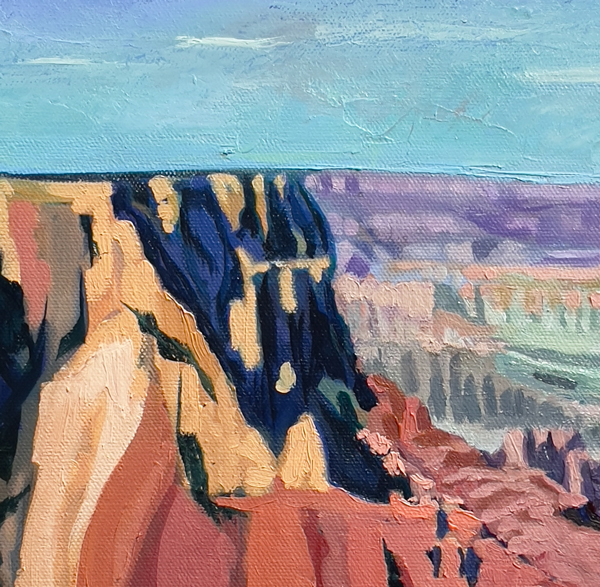On Focal Points

15 February 2024
Create compelling compositions by using your focal point.
Simplifying a composition in a painting
One of my current projects is a series of paintings of the Grand Canyon. The series is a great chance to practice simplifying composition.
There's so much to see in the Canyon!
It's in a constant state of change from light, temperature and air movement. These elements play with the definitions of shape, distance, texture, color and scale.
We're surrounded by wondrous, varied plant and animal zones. An enduring history of place weaves the stories of people and cultures who live or have lived there. There's a sense of the immense scope of time and powerful earth forces that have carved the Canyon.
So yikes, how does one begin to simplify all that enough to get it on one canvas? Still working on that.
Finding the Focal Point
Before I begin a painting, I like to spend a few moments getting quiet.
Whether I'm looking at a reference photo or sketch or painting plein air, I let my attention pull my eyes around. Something will always call to me more. I don't take time to analyze the why. I'm looking for the what. I let that feeling point like a Ouija board to whatever has the strongest pull.
As I organize a composition, I'm establishing the focal point (if I'm using one).
A strong, clear focus can anchor and direct our attention, and energize our painting. There are lots of ways we can establish a clear and commanding focal point in a painting. It's a subject for another series of posts, but here is one tool.
Does every painting need a focal point? Nope. A focal point is one way of organizing and energizing a painting, but there are other means to that end.
A Good Tool for Simplifying Composition
We're usually working on a surface that has edges. All the area contained between the outer edges is a part of the image in some way. But not all the area of a painting has the same role or importance.
We can play with these area hierarchies by making decisions about how much detail we include in any area. This is why it's helpful to begin by establishing big shapes first.
Defining the big shapes creates more edges within the outer edges.
As we build, we have a lot of visual stuff going on, right?
Too much information all at the same level of interest can kill a painting's dynamic impact. (Not always true, but unless you're working deliberately to achieve 100% texture, it's probably true.) We can end up with...boring. So we want to establish interesting places for the eye to travel and focus. To establish hierarchy, we simplify.
How do we simplify the painting's composition?
How do we decide how much detail goes where? What elements or details do we include, and what do we leave out or simplify?
One good trick is to stare at the focal point on the canvas. Keep your focus narrow but soft.
Notice (without refocusing) what's in your peripheral vision. Notice if any areas are competing for your attention with the focal point. Notice the paths your eyes are following. Are you exiting the edges of the canvas? Is there something to pull your eyes back in? Do you need to add something for the eyes to continue its travel around the work? Does your line of travel stop? Is this a dead zone? Do you need to remove obstructions, or add a new line of direction? What happens if you take an area back to a simpler shape?
The Eyes Have It
Once you know what to notice, your eyes will begin to teach you what's important in each painting. You'll begin to see the paths that your eyes follow in a painting. Let the process teach you. You'll learn how to sort and strengthen the paths and create more dynamic and engaging works.
Sometimes I don't know what a painting is about until after I've done it. Often the story or power of a painting comes through the process of asking those questions. Making changes and observing the results gives my inner eye a certain freedom to wander. It also helps calm down my inner critics (I have a whole team of them).
This painting below needs more time. If I get stuck, I'll set it aside and work on something else for a while.
Best regards,
Julia